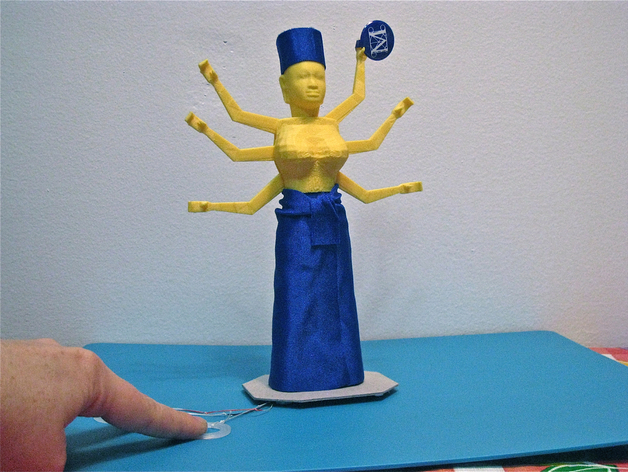
Durga Puppet
thingiverse
The puppet, created by the writer along with their husband Keith Ozar, was designed at the Metropolitan Museum of Art's MakerBot Hackathon. The couple felt bad for the "Standing Female Deity, possibly Durga" missing her arms and decided to make her a full-fledged Durga. Keith captured the head using 123D Catch, while the body and arms were modeled in Blender from photos taken at the gallery. The body was printed on a Thing-O-Matic and the head and arms were printed on a Replicator at the event. Despite some imperfections, the writer believes they did an excellent job for their second MakerBot project. The design is inspired by vintage "Jumping Jack" toys. The arms have two drilled holes each - one for the string (drilled with 1/16" bit) and another for the machine screw (drilled with 3/32" bit). To ensure smooth movement, there should be some play in the hole. The back piece and arms were printed with 25% infill to make them sturdy enough. Cap-headed machine screws of 1/4" length were used. An improvement could be adding pilot holes in the design. Each set of arms is tied together using 12lb line so they can be operated separately, and strings are tied before screwing the arms onto the back. Glue is applied to the knots to avoid untying. Pre-drilled holes for machine screws are recommended, but not too large to allow self-tapping into plastic. Over-tightening should be avoided to keep some play in the screws. The arms are attached, and strings are threaded through the lower half as they're assembled. A keyring is added at the end, and the sarong and hat are made of spandex and attached with clear double-sided tape without sewing. As for accessories, consider what objects the puppet could be holding. Ready for a puppet show!
With this file you will be able to print Durga Puppet with your 3D printer. Click on the button and save the file on your computer to work, edit or customize your design. You can also find more 3D designs for printers on Durga Puppet.
